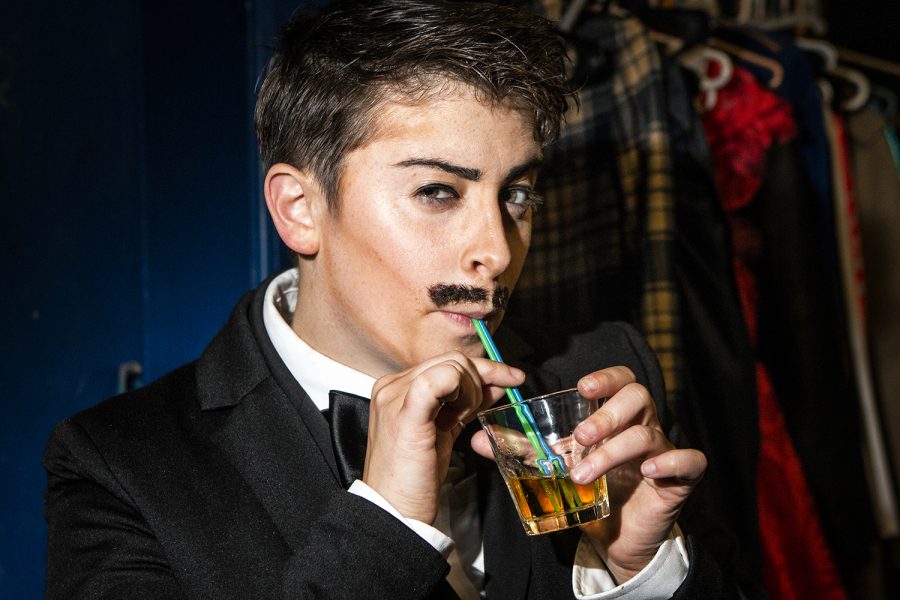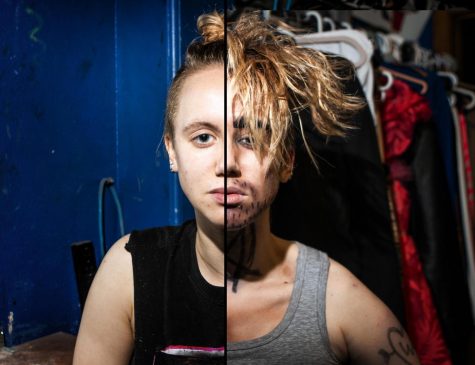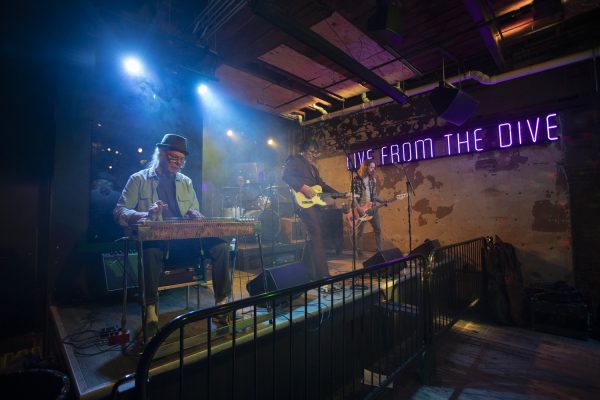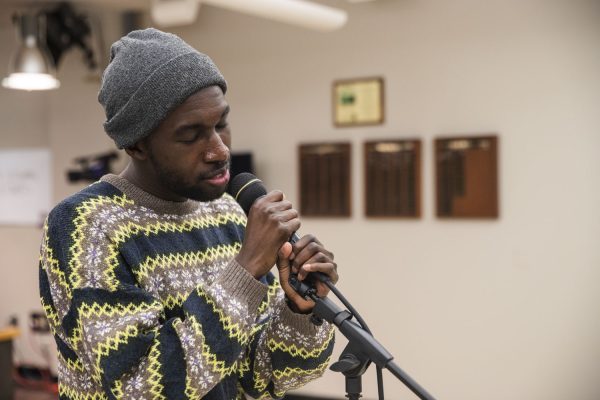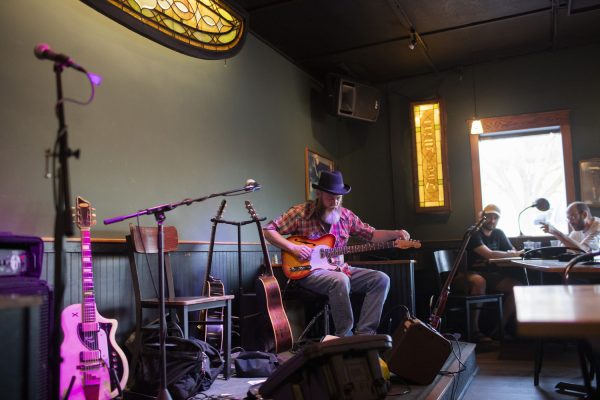Kings of Drag: The secrets behind the fake beards
While drag queens have gained mainstream momentum, drag kings, their male counterpart, are still a growing concept.
I.C. Kings performer Wiley Guyote sips on a drink during I.C. Kings present Netflix and Chill at Studio 13 on Thursday, Aug. 30, 2018.
While getting ready for a show, Amanda Green first puts on a compression shirt to bind her chest. Taking a lighter to burn a wine cork until it turns black, she’ll use the ash to give herself a 5 o’clock shadow and a base for her beard.
With a black eyeliner pencil, Green will make her eyebrows bushier and more prominent. Once the beard is set, Green uses liquid eyeliner to make her facial hair more bold. The look is completed with crepe hair glued to her face, giving the beard a more realistic look.
After an hour has passed, Green transforms into Hugh Jindapants, one of the performers of I.C. Kings, Iowa’s City’s drag-king troupe.
During a difficult point in her life, Green said, she was approached by her sister, who needed an opener for her band. She pushed Green to try out a drag performance, because there weren’t many kings in the area.
For the next nine years, Green said, she’s been “hooked” on drag, finding it empowering to reclaim masculine traits, as if she’s reversing her role in society.
“It was truly the most thrilling, satisfying thing I did in a long time,” Green said. “It was a very cathartic and therapeutic thing for me.”
Franky D. Lover, the leader of I.C. Kings, said he had his first experience with drag performance while he was a student at the University of Iowa. As a former executive board member of the university’s LGBTQ student organization, the group had a tradition in which the members held an annual “drag prom.”
Delving more into the art, Lover noticed a disparity between queens and kings; the drag culture was mostly filled with queens, and most of the kings only performed solo. He wanted to bring in more variety by beginning a drag-king troupe, he said.
Reaching out to different kings in the state, I.C. Kings ultimately formed in 2009. Once the group came together, Lover said, there were more individuals willing to look into becoming drag kings.
“The visibility is huge,” Lover said. “By creating space for drag kings, it helps encourage more variety in drag performance.”
Green had a similar belief.
“I think because of the low representation, there’s a lot of people unaware of these cool things happening in these subcultures,” she said.
While drag queens have reached levels of mainstream success, such as the television series “RuPaul’s Drag Race,” drag kings still remain a minority in popular culture. The subculture of drag kings stems from performers in the 19th century called male impersonators, women who would dress up in traditional masculine clothes to plausibly come off as men, according to a video titled “The History of Drag Kings” from Jezebel.
I.C. Kings performs at Studio 13 on the last Thursday of every month. With each of the kings having a distinct personality, Lover said, the diversity brings in great benefits for entertaining the audience.
“You get an even better show working as part of a group, because each person contributes their unique talents, so you can put on a show you couldn’t do on your own,” Lover said.
To emulate masculine characteristics, the kings will often incorporate aggressive choreography into their routine, similar to a male superstar. This may include jumping around, thrusting, or shaking their fists in the air.
Abel Justice, the most recent addition to I.C. Kings, said he believed his interest in drag first sparked when he watched Hairspray on broadway as a child, where he saw actor Harvey Fierstein play the character of Edna. He would lean over to his mother while viewing the production, whispering to her about how he couldn’t believe it was a man on stage.
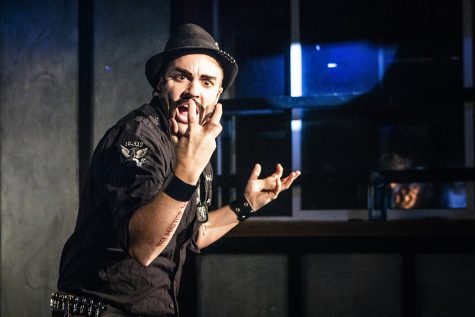
I.C. Kings performer Hugh Jindapants dances onstage during I.C. Kings present Netflix and Chill at Studio 13 on Thursday, Aug. 30, 2018.
Once he moved to Iowa City in 2016, a friend persuaded him to try drag performance. In his first act, he said, he recalled displaying a “farm boy” image, wearing overalls and a straw hat.
Justice said he takes around two hours to prepare for a show. When he had longer hair, Justice would take some strands of his own hair and glue it to his face. Justice exemplifies his party-animal spirit by drawing sharpie tattoos all over himself.
“He has masculine energy, but he’s not sure what to do with it, so it comes out in different ways,” Justice said in describing his character.
Coming from a theater background, he said, he had difficulties finding his niche in performance. With drag, he said, he gets the best of worlds, acting simultaneously as the director, makeup artist, and choreographer.
“There’s a lot of freedom and a lot of power,” he said. “I feel like a heightened version of myself that I don’t often share.”
Outside of entertainment, Lover said, drag performance can carry a political message through its transgressive nature.
“It’s really interesting because just by putting on the costume to perform on stage as a male persona, it inherently makes people think about societal norms of gender and sexuality and question what those really mean,” Lover said. “Some people just see it as entertainment and don’t realize it can be multifaceted.”
Lover said one of the most common misconceptions of drag kings is they’re often conflated with transgender men. An important distinction he made between the two groups was how drag kings are a specific type of performance artist.
“Not everybody is a performer,” he said. “So likewise, not every trans person would want to be on stage, and not every drag performer is trans. But then there are some drag performers who are transgender. The two are not mutually exclusive.”
Justice said people often question drag kings having legitimacy as artists, feeling that others question why a woman would take up male characteristics.
“Sometimes, I feel I get some looks like, ‘Girl, what are you doing?’ ” Justice said. “People don’t really know what to do with it sometimes.”
Although the number of kings remains relatively low in the drag scene, Justice said, he encourages more interested women to try out drag performance, saying they will find the opportunity liberating.
“Just come out and be a rock star,” Justice said.

Email: [email protected]
Twitter: @sstortz_
Sarah Stortz is an Arts Editor at The Daily Iowan. She has been on staff since her freshman year,...
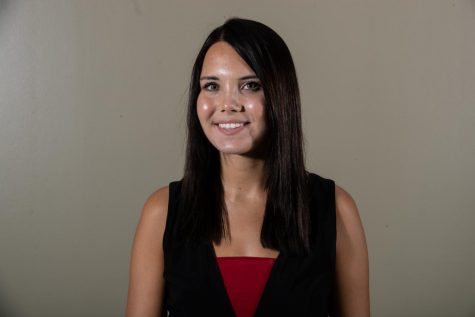
Email: [email protected]
Katina Zentz is the Creative Director of The Daily Iowan. She is a senior at the University of Iowa and transferred from...



